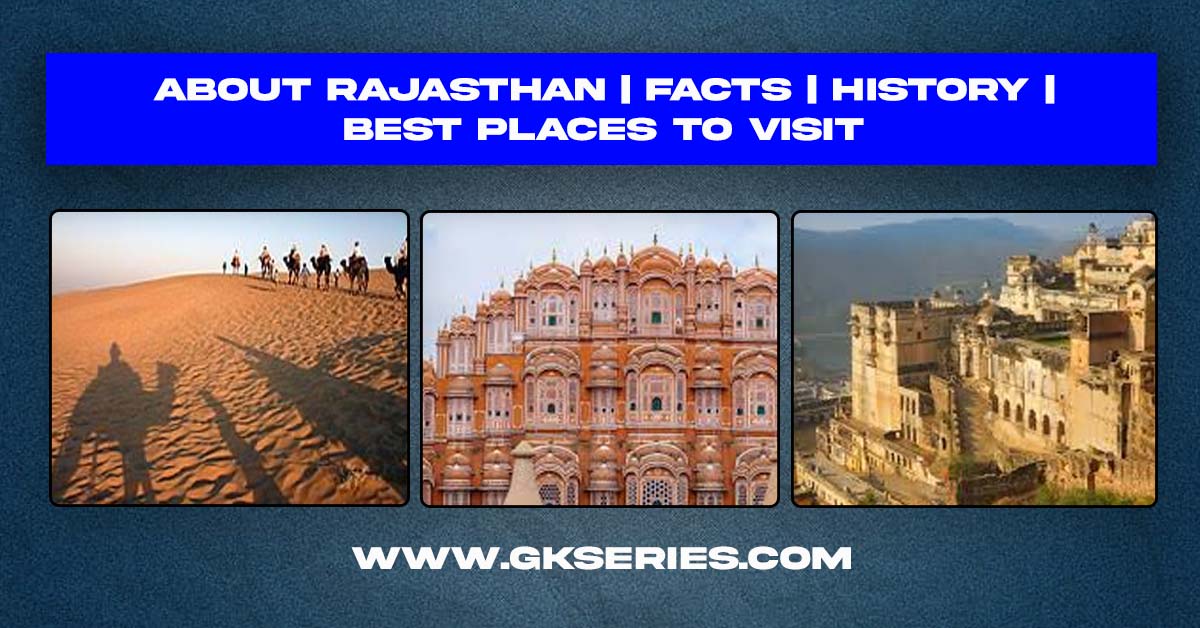
In this article, we provide comprehensive information about the geography, history, population, and top tourist destinations of Rajasthan. Rajasthan, known as the “Land of Kings”, is the largest state in India, located in the northwest region. It is renowned for its rich history, vibrant culture, majestic forts, and desert landscapes.
| About: | Rajasthan is a state located in northwestern India, covering an area of 342,239 square kilometers (132,139 sq mi), which accounts for 10.4 percent of India’s total geographical area. It is the largest state in India by area and ranks seventh in terms of population. Situated on the northwestern side of the country, Rajasthan encompasses much of the vast and arid Thar Desert, also known as the Great Indian Desert. It shares borders with the Pakistani provinces of Punjab to the northwest and Sindh to the west, along the Sutlej-Indus River valley. Additionally, it is bordered by five Indian states: Punjab to the north, Haryana and Uttar Pradesh to the northeast, Madhya Pradesh to the southeast, and Gujarat to the southwest. The geographical coordinates of Rajasthan range from 23°.3′ to 30°.12′ North latitude and 69°.30′ to 78°.17′ East longitude, with the Tropic of Cancer passing through its southernmost point. The State of Rajasthan was established on March 30, 1949, when the states of the Rajputana Agency, which were part of the former British Empire in India, were integrated into the new Indian Union. Jaipur serves as its capital and is also the largest city. Other significant cities include Jodhpur, Kota, Bikaner, Ajmer, Sarwar, Bharatpur, and Udaipur. Rajasthan’s economy is the seventh-largest among Indian states, boasting a gross domestic product of ₹10.20 lakh crore (approximately US$120 billion) and a per capita GDP of ₹118,000 (around US$1,400). In terms of human development index, Rajasthan ranks 22nd among Indian states. |
| History: | The history of Rajasthan dates back to the pre-historic times. Around 3,000 and 1,000 BC, it had a culture akin to that of the Indus Valley civilisation. The Chauhans who dominated Rajput affairs from seventh century and by 12th century they had become an imperial power. After the Chauhans, the Guhilots of Mewar controlled the destiny of the warring tribes. Besides Mewar, the other historically prominent states were Marwar, Jaipur, Bundi, Kota, Bharatpur and Alwar. Other States were only offshoots of these. All these States accepted the British Treaty of Subordinate Alliance in 1818 protecting the interest of the princes. This naturally left the people discontented. After the revolt of 1857, the people united themselves under the leadership of Mahatma Gandhi to contribute to the freedom movement. With the introduction of provincial autonomy in 1935 in British India, an agitation for civil liberties and political rights became stronger in Rajasthan. The process of uniting scattered States commenced from 1948 to 1956 when the States Reorganisation Act was promulgated. First came Matsya Union (1948) consisting of a fraction of states, then, slowly and gradually other states merged with this Union. By 1949, Major States like Bikaner, Jaipur, Jodhpur and Jaisalmer joined this Union making it the United State of Greater Rajasthan. Ultimately in 1958, the present State of Rajasthan formally came into being, with Ajmer state, the Abu Road Taluka and Sunel Tappa joining it. |
| Geography: | Rajasthan is characterized by its distinct geographic features, including the Thar Desert and the Aravalli Range. This range stretches across the state from the southwest to the northeast, covering over 850 kilometers (530 miles). At the southwestern end of the Aravallis is Mount Abu, which is separated from the main range by the West Banas River. A series of broken ridges extends into Haryana towards Delhi, where they appear as outcrops like the Raisina Hill and other ridges further north. Approximately three-fifths of Rajasthan is located northwest of the Aravallis, while the remaining two-fifths are situated to the east and south. |
| Country : | India |
| Region: | North India |
| Capital and largest city: | Jaipur |
| Language: | Hindi |
| Population: | 68,548,437 (2011) |
| Literacy rate: | 66.11% (2011) |
| Major Attractions to Visit: | Amer Fort (Jaipur) City Palace (Jaipur) Hawa Mahal (Jaipur) Jantar Mantar (Jaipur) Lake Pichola (Udaipur) City Palace (Udaipur) Jag Mandir (Udaipur) Mehrangarh Fort (Jodhpur) Umaid Bhawan Palace (Jodhpur) Jaisalmer Fort (Jaisalmer) Sam Sand Dunes (Jaisalmer) Chittorgarh Fort (Chittorgarh) Ranthambore National Park (Sawai Madhopur) Pushkar Lake (Pushkar) Brahma Temple (Pushkar) Ajmer Sharif Dargah (Ajmer) Dilwara Temples (Mount Abu) Nakki Lake (Mount Abu) Keoladeo National Park (Bharatpur) Kumbhalgarh Fort (Rajsamand). |





